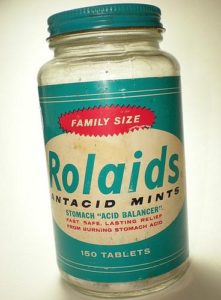Antacids- Awareness and Appreciation
Antacids- Awareness and Appreciation
Author: Mark Parkinson BSPharm: President AFC-CE
Credit Hours 1- Approximate time required: 60 min.
Educational Goal:
Increase Adult Foster Care providers awareness of antacid drug class.
Educational Objectives:
Inform about the history of popular antacids.
Define the basic chemistry of gastric acid and pH.
Explain how antacids work.
List the side effect profile of antacids and what to monitor for.
Procedure:
Read the course materials. 2. Click on exam portal [Take Exam]. 3. If you have not done so yet fill in Register form (username must be the name you want on your CE certificate). 4. Log in 5. Take exam. 6. Click on [Show Results] when done and follow the instructions that appear. 7. A score of 70% or better is considered passing and a Certificate of Completion will be generated for your records.
Disclaimer
The information presented in this activity is not meant to serve as a guideline for patient management. All procedures, medications, or other courses of diagnosis or treatment discussed or suggested in this article should not be used by care providers without evaluation of their patients’ Doctor. Some conditions and possible contraindications may be of concern. All applicable manufacturers’ product information should be reviewed before use. The author and publisher of this continuing education program have made all reasonable efforts to ensure that all information contained herein is accurate in accordance with the latest available scientific knowledge at the time of acceptance for publication. Nutritional products discussed are not intended for the diagnosis, treatment, cure, or prevention of any disease.
Antacids- Awareness and Appreciation
Antacid is one of those medicines that we all have seen on store shelves, on TV advertisements, and in our medicine cabinets all our lives. We see antacids so often we take for granted their use and understanding. Little do we appreciate the chemistry behind these wonderful remedies, and we are unaware of what they really do for us. So, let us now contemplate antacids.
Antacids are among the oldest known medical treatments in human history. There are records of antacids in ancient Sumerian texts written on clay tablets that date back 3500 years before Christ. They used a combination of milk, peppermint, and a material they found in plant ash. Today we call it sodium bicarbonate. Over the following centuries other materials were gradually added to the cures for upset stomachs. Their development was mainly a case of accidental discovery or trial and error. It was not until the development of the modern science of chemistry that we understood why these substances worked. After the basic principles were discovered, the full range of products we now call antacids were created.
|
The History of Milk of Magnesia. In 1829 James Murray, an Irish doctor, used a magnesia solution to treat the stomach pain of a prominent local official. It worked so well that he was named resident physician of Anglesey and subsequently knighted for his work. After his death an English pharmacist, Charles Henry Phillips, created a set formula for the suspension of magnesia in 1873. He called it Phillips Milk of Magnesia. |
The Basic Principles- Anatomy and Physiology
GI Tract
To understand the basic principles of antacids we must first consider how the gastrointestinal (GI) tract works. The GI tract is a system that takes in food, digests it by breaking it apart both physically and chemically, absorbs the nutrients, and expels what is left over as waste. It essentially is a tube that goes through the body which is closed off at various sections. In each section a different set of actions and reactions occur that processes the food we eat. For the purposes of this CE we will mainly concentrate on the acidity and alkalinity functions of the digestive systems.
Acid and Bases
An acid is any chemical that is capable of donating a hydrogen ion (proton or H+) in a chemical reaction. The higher the concentration of these hydrogen ions in a solution, the more acidic it is. Acidity is measured using the pH scale. The pH scale ranges from 0 to 14. The lower the number, the higher the acidity is, which is kind of counterintuitive. It’s a complex logarithm calculation math thing, so we won’t go into it. Hydrogen ions are very reactive with other substances. They can disrupt the chemical bonds that hold molecules together. This comes in very handy when we need to chemically break down the foods we eat.
A base (also known as an alkaline or caustic) is any chemical that is capable of donating a hydroxide ion (-OH). The higher the concentration of the hydroxide ion, the more caustic it is. On the pH scale acidic is 0–7 and alkaline is 7–14. The higher the pH, the more basic it is. It’s that logarithm math thing again. The hydroxide ion is about as reactive as an acid is, so our body also uses it to dissolve the food we eat.
You will notice that if you put an acid (H+) and a base (-OH) together you get HOH or H2O, water. Commonly we call the type of chemical reaction a neutralization (it’s that pesky but useful pH logarithm thing again). pH 7 is considered neutral. Neutralization is how the body controls the pH level of the food slurry solution as it passes through the gut.
|
The History of Pepto-Bismol Bismuth salts have been used for medical purposes since the 1700s. In around 1900 a New York doctor started to sell a suspension of bismuth salts and called it Bismosal: Mixture Cholera Infantum. It was later renamed by the Norwich Eaton pharmaceutical company to Pepto-Bismol. In 1982 Norwich Eaton was bought by Proctor & Gamble. |
pH and the GI Tract
It takes a lot of effort to break down the food we eat. We rely heavily on the acids and bases to do the job for us. The juices in our stomach are called stomach acid for a reason. Stomach acid measures on the pH scale at about 1–2 pH, the same as battery acid. As the food slurry passes into the intestine the body starts to neutralize it. The small intestine measures about pH4–5 and the large intestine ends with about pH7. A pH of 1–2 is very, very strong. It can dissolve just about everything we eat, kill most bacteria and other microscopic critters, and it can even eat through metal.
So why doesn’t the acid eat through our GI tract? The stomach has layer upon layer of protection. There are thick mucus layers; under that there is a layer loaded with more alkaline material ready to neutralize the acid, and stomach cells are among the fastest reproducers in our body. To top it off, each end of the stomach is closed off by strong sphincter muscles that keep the acid in the stomach. The intestine has similar defenses plus cells and organs that pump alkaline material in to neutralize the acid. The throat and esophagus have some protection too, but they rely mostly on the upper stomach sphincter for protection. Finally, the body controls the quantity of acidic material, keeping the volume low when there is no food to digest.
pH and the Symptoms We Feel
As just about everyone has experienced, sometimes our acid protection fails us. If the stomach acid leaks out through the upper sphincter we call that heartburn; if it occurs on a continual basis, we call that gastroesophageal disease (GERD). If the acid builds up in our stomach or small intestine and starts to cause problems, we call that a stomachache. If the acid makes it past the mucus layers and starts to eat a hole in our guts lining, we call
that an ulcer. Stomach acid may not be the only thing causing the symptoms, but it is certainly a major factor.
|
The History of Alka-Seltzer Alka-Seltzer was produced by Miles Laboratories in 1931. It contains aspirin, sodium bicarbonate, and anhydrous citric acid. When added to water the bicarbonate and citric acid undergoes a chemical reaction with the water that creates the effervescent bubbles. Alka-Seltzer’s popularity is due in large part to its clever advertising and product effectiveness. Who can forget the slogan “pop pop fizz fizz, oh what a relief it is,” or “I can’t believe I ate the whole thing.” |
The Basic Principle – The Chemistry of Relief
Medical research has discovered that many of the common symptoms that afflict patients are related to the simple acid-base chemical reaction. Several enterprising entrepreneurs thought that they could utilize the chemical mechanisms and created new products that could be used to relieve the acid-created problems. Even old tried-and-true stomach remedies were looked at with a greater understanding. The basic principle behind all of this medical activity was acid neutralization. Eventually all those products were combined under the drug category of antacids, or just antacids. Today there is a long list of approved antacid products. All of them utilize the same basic chemistry of relief.
Table: Basic Antacids
|
Antacid |
Formula(1)
|
Neutralizing Power |
Unwanted Effects |
|
Sodium Bicarbonate |
NaHCO3 |
low |
Fluid retention, Alkalosis |
|
Magnesium Hydroxide |
Mg(OH)2 |
high |
Diarrhea, Magnesium toxicity |
|
Aluminum Hydroxide |
Al(OH)3 |
modest |
Constipation, Drug or phosphate binding (inhibits absorption) |
|
Calcium Carbonate |
CaCO3 |
very high |
Acid rebound |
(1) Al= aluminum; Mg = magnesium; Ca = calcium; Na = sodium
Source https://www.iffgd.org/diet-treatments/antacids.html?showall=&start=0
Some Special Notes About Antacids -
- If sodium bicarbonate sounds familiar to you, it is. It’s part of every kitchen and many common food recipes. You probably know it as baking soda. Baking soda mixed in a drink has been a home remedy for decades. It is also an important ingredient in soda crackers, which explains why they are used so often to relieve an upset stomach.
- Antacids also inhibit the enzyme pepsin, which helps in the breakdown of proteins. Pepsin is also thought to contribute to indigestion problems.
The Pharmacology of Antacids
So far, we have discussed why antacids work. Now let’s get into some details on how they work. This section will be the most important to caregivers. They need to know what to expect from the antacids they dispense and what to watch out for. I am also going to pass on a few pharmacist tricks on how to make the medication more effective and easier to use.
Antacids vs. Time
The neutralizing effect of antacids works almost immediately when they come into contact with gastric acids. Unfortunately, since they don’t dissolve well in liquids, some of the chunks of the antacid never mix with the stomach acid. The longer it takes to dissolve completely, the longer it takes the antacid to work. In my experience products that are easier to swallow whole, like soft chews, gummy tablets, or some tablets, take longer to work.
Tablet vs. Suspension
Antacids work the best when they are ground up. The finer the grind, the greater the surface area that is available to interact with the gastric acid. That is why suspensions work faster and more potently than tablets. If tablets are used, make sure that they are chewed completely before swallowing. If needed, the caregiver could grind up and dissolve the tablet in a flavored drink before giving the antacid to the resident. If the flavor or texture bothers the resident, try hiding it in applesauce or chocolate pudding. The applesauce can hide the texture and the chocolate flavor usually can hide any other unappealing flavor.
Antacid vs. Food
Antacids are short-term measures; their effect is only temporary. Either all the antacid material is used up neutralizing the acid, or it passes through the stomach too quickly. One way for the caregiver to make antacids work for longer periods of time is to give it with food. Antacids given by themselves usually last about an hour. If you give them with food, movement through the stomach naturally slows down for digestion purposes. The antacid effect can be stretched out for up to three hours. Caregivers should know that the acids in highly acidic foods like orange juice and spicy foods will use up some of the neutralizing power of the antacid and waste some of its effect.
|
The History of Rolaids and Tums Two popular antacid tablets whose active ingredient is calcium carbonate are Tums and Rolaids. Tums was invented in 1928 by the pharmacist James Harvey in the basement of his St. Louis, MO, home. He originally made it to treat his wife’s indigestion. Rolaids was invented by American chemist Irvine W. Grote in the late 1920s in Chattanooga, TN. At first Rolaids had no flavoring, which made it very chalky-tasting. Later, a variety of flavors were added. |
Antacid vs. Side Effect
Antacids are usually considered safe to use for the general public. As you already know from my other CE courses, there are always potential side effects to monitor for. Side effects from the occasional use of antacids usually go away by themselves. The more often they are used, the greater the chance of more serious effects occurring. Caregivers should be extra vigilant when new medications are started and when unusual occurrences crop up in long-term usage of antacids.
- Magnesium-containing products cause diarrhea. Milk of Magnesia is usually given for this effect.
- Aluminum-containing products cause constipation. Antacid manufacturers have added aluminum and magnesium together to offset each other’s effect.
- Calcium also constipates. Caregivers should watch for this effect, especially if calcium supplements are also taken. You can manage this by drinking extra fluids.
- Sodium bicarbonate creates CO2 gas bubbles when neutralizing acids. Though burping can give a satisfying feeling, bloating and gas pressure can be uncomfortable for some patients. The extra sodium might become a problem with low-sodium diets, weak kidneys, and uncontrolled high blood pressure.
- Calcium carbonate and, to some extent, all other antacids can cause an acid rebound—an increase of acid production at a later time. It’s a matter of the antacid working too good. The homeostatic mechanisms of the body
will increase gastric acid production if its concentration falls too low. If this becomes a problem, caregivers can try lowering the antacid dose.
- If large doses of antacids are used often, caregivers should monitor for milk alkali syndrome. Symptoms include headache, nausea, irritability, and weakness. Contact the doctor if this occurs.
- High doses of aluminum can cause mental problems. It can also drop blood phosphate levels too low, causing muscle weakness, anorexia, and weakened bones. If the resident has osteoporosis or problems with anorexia, the caregiver should request another type of antacid.
- Antacids should not be given to children under six years of age.
- The extra minerals in antacids may contribute to certain types of kidney stones.
- Antacids can interfere with some medications. Consult the drug information leaflets to see if it’s a problem. Here again the occasional antacid use is not a big issue. The more often they are used, the more monitoring is required by the caregiver.
Final Caregiver Notes
Antacids are symptom relievers only; they are not cures. If there is a serious underlying issue causing the acid symptoms, then taking an antacid is only hiding the problem. Caregivers should pay attention to the PRN log. If there is a sudden increase or prolonged use, the caregiver should start asking more questions—first to the patient, and then the doctor.
Peppermint naturally relaxes sphincter muscles. It can help move food through the stomach (hence after-dinner mints), which can help reduce stomach acid, but it can also exacerbate GERD problems. Use with skill and caution.
Remember, if foods like peppermint and soda crackers start to become therapy, contact the doctor first.
If the caregiver sees an unusual amount of mental confusion in their residents, check the PRN log for antacid use. If you see a correlation between the two, pass the observation on to the doctor and request blood tests to be done.
Conclusion
Antacid use for stomachaches and heartburn has been with us for centuries. When chemistry studies came along, we found out why these remedies worked. Antacids are generally considered safe and effective, but as with all therapies, they must be used with skill and monitoring. Side effects may occur, and more serious problems may be hidden with continued antacid use. Caregivers should always monitor for effect and pay attention to the PRN logs. The entries can give important clues that might be an indication of more serious issues that may be occurring.
As always Good Luck in your caregiving efforts.
Mark Parkinson BSPharm
References:
Heartburn Treatment. Cleveland Clinic. 08/15/2016. https://my.clevelandclinic.org/health/treatments/9624-heartburn-treatment
Antacids. Healthline.com. 2018. https://www.healthline.com/health/antacids
- Fookes, BPharm. Antacids. Drugs.com. https://www.drugs.com/drug-class/antacids.html
Taking antacids. Medlineplus.com. NIH. https://medlineplus.gov/ency/patientinstructions/000198.htm
The History of Antacid. Kick Node. https://kicknode.com/the-history-of-antacid/
K.Thor Jensen. The Ancient History od Antacids. Geek.com. 7/5/2017. https://www.geek.com/science/the-ancient-history-of-antacids-1705782/
Annette (Gbemudu) Ogbru, PharmD, MBA. Antacids. Rx List.com. https://www.rxlist.com/antacids/drugs-condition.htm
Antacids. Encyclopaedia Britannica.com. https://www.britannica.com/science/antacid
Antacids. International Foundation for Gastrointestinal Disorders. Sep.4.2015. https://www.iffgd.org/diet-treatments/antacids.html?showall=&start=0
Exam Portal
click on [Take Exam]
Purchase membership here to unlock Exam Portal.
|
|
|
|
|
*Important*
Registration and login is required to place your name on your CE Certificates and access your certificate history.
Username MUST be how you want your name on your CE Certificate.
| Guest: Purchase Exam |







